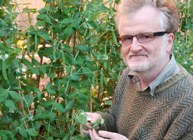To flower or not to flower

Professor Noel Ellis
26 April 2012
An unusual strain of plant that never flowers has enabled scientists to isolate a gene that is essential for the formation of the branches on which flowers form.
Writing in Nature Communications on Tuesday 24 April, an international team of scientists which includes Professor Noel Ellis from Aberystwyth University, outline how they studied a mutant pea plant, Pisum sativum, to identify the gene that leads to formation of flowering branches on plants.
By comparing it with flowering plants, the researchers were able, after many years of painstaking research, to identify a gene that controls the development of these branches on plants.
Professor Ellis from the Institute of Biological, Environmental and Rural Sciences (IBERS) at Aberystwyth is an expert on legumes - plants such as peas and clover.
He believes this work puts in place the methods, principles and expertise needed to use genetics for the development of more productive and environmentally beneficial legumes.
Professor Ellis explained; “The number and distribution of flowers on a plant is an important part of its survival strategy, here we have a key to understanding this for legumes. This discovery leads us to some possible ways to look for variation in the number and distribution of flowers on legume crops and this could have an impact, for better or worse, on crop productivity.”
The original research was the joint effort of one of the Spanish and Australian authors studying the plants that grew normally but never flowered. They believed that they would be able to identify the gene for flowering.
However, they were faced with a major hurdle. They only had one example that didn’t flower, and no good science is based on one observation.
Many years later, the team were able to disprove their original hypothesis and identify a second gene nearby which was required for the development of these branches on the flowering plants.
The paper “VEGETATIVE1 is essential for development of the compound inflorescence in pea” was published in Nature Communications on Tuesday 24 April 2012.
The full listing of authors and their affiliations for this paper is as follows:
Ana Berbel1,*, Cristina Ferrándiz1,*, Valérie Hecht2, Marion Dalmais3, Ole S. Lund4,†, Frances C. Sussmilch2, Scott A. Taylor2,5, Abdelhafid Bendahmane3, T.H. Noel Ellis5,6, José P. Beltrán1, James L. Weller2 & Francisco Madueño
1 Instituto de Biología Molecular y Celular de Plantas, Consejo Superior de Investigaciones Científicas–Universidad Politécnica de Valencia, Valencia 46022, Spain.
2 School of Plant Science, University of Tasmania, Hobart, Tasmania 7001, Australia.
3 Unité de Recherche en Génomique Végétale, UMR INRA-CNRS, Rue Gaston Crémieux, Evry Cedex 91057, France.
4 Department of Plant Biology, Danish Institute of Agricultural Sciences, Thorvaldsensvej 40, Frederiksberg C DK-1871, Denmark.
5 John Innes Centre, Colney Lane, Norwich NR4 7UH, UK.
6 Institute of Biological, Environmental and Rural Sciences Aberystwyth University, Gogerddan Campus, Aberystwyth SY23 3EB, UK.
†Present address: Department of Agriculture and Ecology, University of Copenhagen, Taastrup 2630, Denmark.
Professor Noel Ellis
Dr Noel Ellis is professor of Crop Genetics and Phenotype Biology at the Institute of Biological, Environmental and Rural Sciences at Aberystwyth University. He is the leader of the Genome Diversity theme and joined IBERS from the John Innes Centre at Norwich in early 2011.
Plant architecture
Flowering plants first appeared around 120 million years ago and the first legumes – plants such as the nitrogen fixing peas and clover - appeared around 60 million years ago. As flowering plants have evolved increasingly complex architectures have developed.
Tulips on the one hand have a simple architecture, a single stem on the end of which grows a single flower. Willow herb on the other hand, which is commonly seen growing on wasteland and along railways, has a more complex architecture with many flowers together at the top of the plant with each one on a little branch growing out of the main stem and a fantastic show of pink flowers.
The work published this week in Nature Communications has identified the gene that specifies that these branches are to be formed, which in turn leads to the formation of more flowers.
Nitrogen dividend
Developing new varieties of legumes, which transfer nitrogen into the soil, could yield significant benefits for farmers and benefit the environment.
Rising energy costs mean that the manufacture of nitrogen fertilisers is increasingly expensive and the process can lead to the production of nitrous oxide, a greenhouse gas that is around 300 times more damaging to the environment than Carbon Dioxide. Agriculture contributes about 75% of European greenhouse gas emissions by this route, with various estimates putting this at between 12 and 25% of our total greenhouse gas production.
Scientists working at Aberystwyth have a long and distinguished history of pioneering the development of new varieties of white and red clover. These include AberAce, AberCrest, AberPearl, AberHerald, AberDai, AberConcord and AberRuby.



